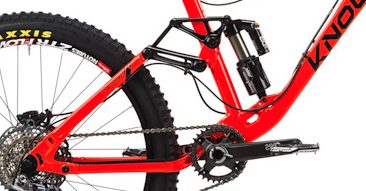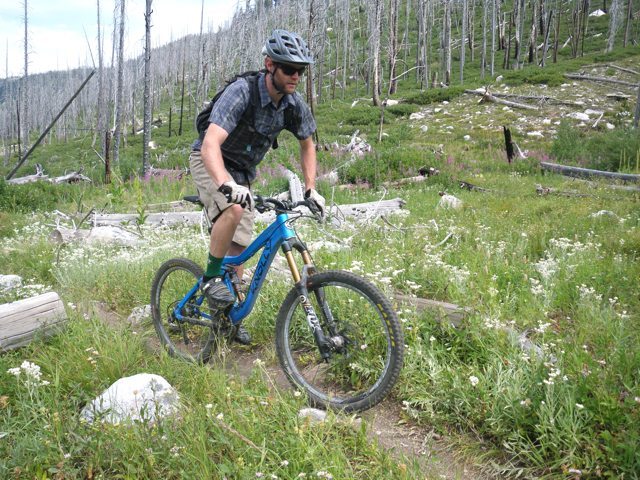4xFour Suspension
Now, onto the Chilcotin’s suspension system and how it compares to the suspension design of the Scapegoat. This will be a quick reminder of the differences between the two bikes—for a more in-depth look at these systems, check out the Suspension 101: Designs post.
The Scapegoat uses the linkage driven single-pivot (four-bar) design found on many other bikes. A four-bar linkage is basically any linkage that has four bars held together with four pivots and one degree of freedom. Diamondback’s Kuncklebox changes the spring rate of the system, while the wheel path follows the arc allowed by the single pivot relative to the chain stay / seat stay lengths. This design is easy to produce and less expensive because there’s no patent.
This type of system offers great bump compliance, but often has pedal and brake feedback.
Knolly uses their patented 4xFour system on the Chilcotin. At first glance, the rear pivot may look similar to a horst-link design (and there are definitely some similarities where braking performance and bump compliance are concerned—which is a good thing), but it’s the second set of linkage bars that sets the 4xFour apart.

This second set of links control the shock’s leverage ratio as it moves through its travel, giving the bike a super supple feel in the beginning and middle of its stroke that gets progressively firmer as the bike moves through its travel—this prevents bottom outs on harsh hits.
The link at the rear drop out modifies the rear wheel’s path to be more vertical—this leads to better bump compliance and traction under braking. Called an “active” system, this type of design tends to be less efficient when it comes to pedalling than some other patented designs that are currently on the market.
A few other key things to mention about the 4xFour is that allows Knolly to do several things at once:
- Use a full-length seat tube.
- Place the seat tube in front of the bottom bracket so that when the seat is lowered, there’s no rider interference. (I mentioned this above under “Fit”.)
- Increase lateral rigidity in the rear end by keeping the suspension linkage components (i.e. seatstay and chainstay) as short as possible. This is why the rear end on the Chili looks puny compared to its much larger-tubed front end.
- Orient the rear shock in a position that allows for long shock stroke lengths. This means that the frame has a low shock rate, which improves suspension performance.
- Completely isolate the rear shock from any side loading. No flex. Period.
Knolly’s 4xFour linkage lets rear wheel travel in a slightly more vertical path, as opposed to the Scapegoat’s arc-shaped wheel path. The placement of the rear pivot makes for better braking performance by isolating braking forces and absorbing bumps. Now, let’s talk about the ride.
The ‘Up’
I’d heard talk about how the Chilcotin’s suspension is tuned for traction and excels on nasty, techy climbs. Joe talked about how how impressed he was by the bike’s traction on loose, low-speed climbs, but he sold his Chilcotin because of a lack of “pep in its step,” and opted instead for the Knolly Endorphin.
I wanted to test his findings, so I hit the worst climb in my area—Goose Creek just outside of McCall, with its steep, slimy roots and slick boulders that test your balance and stamina.
First off, let me admit that this is my first experience with the new Fox CTD damper and it took a bit of getting used to. I’ll also admit it’s been awhile since I’ve ridden anything other than a two-link (Giant Maestro) or four-bar (DB Knucklebox) design, where pedalling forces are largely absorbed by either the linkage design or the shock.
With the CTD in Climb mode I set off to mash my way up some gnar. Holy. Shit. This bike sticks to the ground like Velcro. It’s best to climb seated on the Chilcotin, with weight on the rear wheel to help it dig deep and stick amazingly well. I’ve noticed that when I want to hammer up a short climb, I lose some traction when the rear end is unweighted. If you have the patience to sit and spin, the Chili will tractor up damn near anything.
The Chilcotin’s active rear end combined with its more vertical wheel path moves the rear wheel up and over obstacles, as opposed to the ‘Goat’s square-edged “bump-into” effect. This could be due to the ‘Goat’s DHX rear damper, which I thought never let the bike feel right—I couldn’t find a good balance between small bump compliance (climbing traction) and bottom out control.

The Knolly’s active rear end robs a little more power than the Giant Maestro’s does, but it makes up for it with insane amounts of traction. I’m continually impressed by the rear wheel’s ability to dig in when you need it to. The only conceivable limitations here are your legs and your rear tire.
On roads or flatter climbs, the 4xFour feels a bit sluggish—there’s a sense of “I’m working harder than I should be right now.” But honestly, it’s wishful thinking to hope that a 30lb, 6.3” bike with a 66o head angle and 2.4” tires will pedal like a hardtail…
The Chilcotin performed like the Scapegoat (a bike I tested on 100+ miles of road at the White Rim) on less technical trails and service roads. This is to be expected—both are ~30lb, 6” bikes with some sort of pro-pedal shock feature. But the Chilcotin’s small bump compliance was significantly better than the ‘Goat’s.
Access roads are not the Chili’s forte. In Climb mode, the bike will spin to the top just fine, but where the Chili shines is on slow, grinding, steep “I can’t make it” sort of climbs where the rider remains seated for balance and to steer around and over obstacles, and maintaining traction becomes increasingly important.
The Climb mode on the RP23 does a decent job canceling pedal-bob and I usually use this setting when I’m climbing. But I spend the majority of my rides in Trail mode since it seems to be almost as good at neutralizing pedal forces as the Climb setting, and the trails where I live roll so much that it’s a pain in the ass to keep switching between modes.
If you have good balance and a strong set of legs, this bike will take you up anything. Look into the Chilcotin’s little brother, the Endorphin, if your local trails are accessed by service roads or you’re not ready to take the long-travel plunge. The Endo has the same suspension with a lighter frame and slightly steeper angles.
NEXT PAGE: The ‘Down’

first time I’d ride tis bike, yess this bike needs more power to pedal for long way.
but when you found what kind of technic to pedal this bike, it become a beast on all kind of trails
very efficient, very stiff, smooth handling, you can push your own limits with no doubt
I am glad to have knolly’s bike